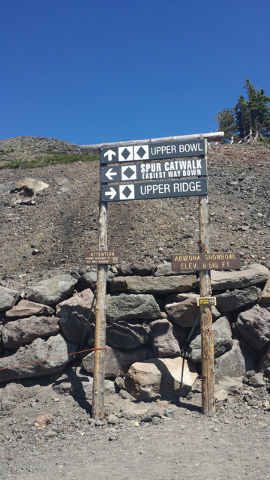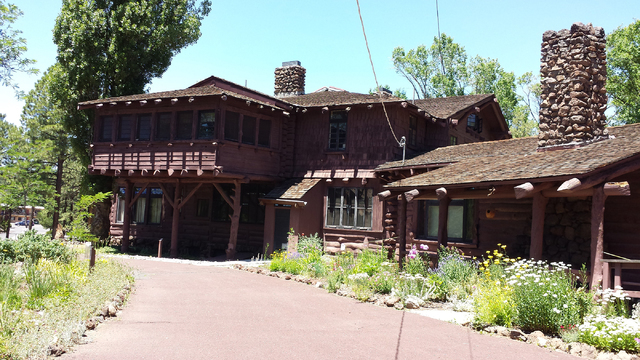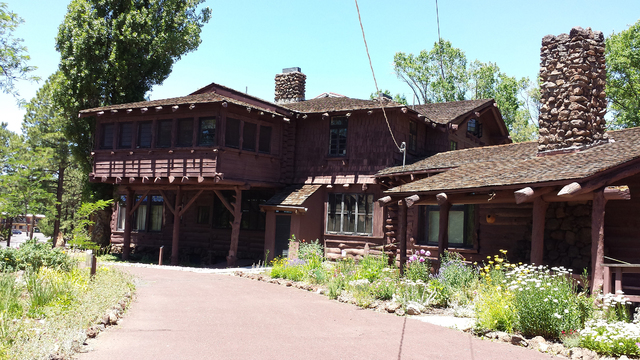Fall color, scenic views, historic stops and the night sky beckon visitors to Flagstaff
The aspens on Mount Charleston put on a great golden show every autumn, but if you’re looking for more extensive fall color — or just a chance to get away — Flagstaff, Arizona, is a great choice.
According to the Flagstaff Ranger District of Coconino National Forest, color in the upper elevations of the mountains around the old railroad town is peaking this week, and the maples and other deciduous trees there promise a variety of color.
Flagstaff is an easy drive from Las Vegas, about four hours via U.S. Highway 93 and Interstate 40, so a late-afternoon departure should bring an early evening arrival. The surrounding mountains present themselves in a panoramic view, but if you want to get closer to the color, head up to the Arizona Snowbowl chairlift, which is reached by driving north on U.S. Highway 180 over a well-marked route. The base of the chairlift (where there’s a restaurant, bar and shop) is at 9,500 feet; hop on a chair and soon you’ll be climbing up, up, up, as the sparkling, quaking leaves of the aspen trees give way to the evergreens at the highest elevations. Twenty minutes later you’ll be at 11,500 feet. At the top of the mountain are hiking trails, restrooms, water, a National Park Service guide brimming with information and broad-spectrum views of the surrounding area. Through mid-October the chairlift operates on Fridays, Saturdays and Sundays, with the last chair departing at 4 p.m.
Closer to Flagstaff’s average elevation of about 7,000 feet is the Riordan Mansion State Historic Park, on West Riordan Road. The park is the site of duplex mansions built by brothers who were married to sisters in 1904. The Riordan brothers were the owners of the Arizona Lumber &Timber Co., the major employer in town, and in the spirit of noblesse oblige they contributed much to the community, by way of medical care, the Catholic church and educational opportunities at various levels.
The adjoining houses, which were designed by the architect of El Tovar Lodge on the south rim of the Grand Canyon, are, like it, in arts and crafts style. A guided walking tour of the house and self-guided tour of the grounds provide rich insights into life in a frontier town near the beginning of the 20th century. Among the artifacts worth noting are the windows in the common area between the houses, which are infused with scenes from the Southwest and portraits of American Indians. The original windows had significantly deteriorated by the time Riordan successors gave the property to the state in the late ’80s, but the majority were replicated from the original photographs, which were found in the Smithsonian Institution and National Archives in Washington, D.C. The others were re-created using digital technology.
The Riordan family also was instrumental in bringing the Lowell Observatory to Flagstaff in 1894. At the observatory at 1400 W. Mars Hill Road you can see the telescope on which Pluto was discovered. Programs include viewing of the sun with a solar telescope during the day, live interactive presentations with the observatory’s indoor astronomy show and a look at the planets, moon and stars at night. Hours during September and October are from 9 a.m. to 9:30 p.m. Mondays, Wednesdays, Fridays and Saturdays and 9 a.m. to 5 p.m. Tuesdays, Thursdays and Sundays.
Flagstaff, with a population of slightly more than 70,000, covers a relatively small area, so navigating is easy. Drive north on any of the exit roads from Interstate 40 and you’ll find yourself in the downtown area, with a stretch of Route 66 and the campus of Northern Arizona University.
A good place to gather information is the Flagstaff Visitor Center, in the old train station at 1 Historic Route 66. Along nearby Beaver, Humphreys and Leroux streets cluster shops and restaurants. Altitudes Bar and Grill, at 2 S. Beaver St., has an outdoor patio where live music is a frequent feature on weekends and the fare leans to snacks and sandwiches. If the music seems a little loud, it’s to compensate for the frequent trains roaring by maybe 100 feet away.
The Beaver Street Brewery, at 11 S. Beaver St., was Flagstaff’s first microbrewery when it opened in 1994. A big, sprawling place, it offers comfort food such as chicken potpie and meatloaf, wood-fired pizzas, salads and sandwiches and two varieties of fondue.
Flagstaff is a multifaceted town, and in addition to the influences from skiing, railroads and Historic Route 66, it’s very much a college town, and NAU students bring a contemporary flavor to all that history. Many of the university’s events, including lectures, film series and sporting matches, are open to the public. NAU’s students also put their stamp on the town with a relaxed, casual vibe that includes dog-friendly policies at most local businesses and frequent sightings of men in kilts, which no doubt would amuse the Riordans.
Contact Heidi Knapp Rinella at hrinella@reviewjournal.com. Find more of her stories at www.reviewjournal.com and follow @HKRinella on Twitter.
IF YOU GO
Directions: Flagstaff, Arizona, is about 250 miles from Las Vegas. To get there, drive south on U.S. Highway 93 to Kingman, Arizona, then east on Interstate 40 into Flagstaff.
Information: For details on scheduled events, activities, and dining and accommodations, visit the website of the Flagstaff Convention and Visitors Breau at www.flagstaffarizona.org, or call (800) 379-0065. You also can get a real-time look around with the webcams on the site.
Accommodations: Flagstaff is home to numerous chain and privately owned hotels, including the historic Hotel Weatherford, which originally opened in 1900; visit weatherfordhotel.com. There also are numerous bed and breakfasts and camping sites in the area.
Attractions: Fall rates for the chairlift at the Arizona Snowbowl are free for kids 5 and younger, $13 for those 6-12 or older than 65, and $19 for other adults. Get a 20 percent discount by buying tickets in advance at www.arizonasnowbowl.com.
Admission to The Riordan Mansion State Historic Park is $10 for adults, $5 for children 7 through 13, and free for kids 6 and younger. Reservations recommended; call 928-779-4395. More information is available at azstateparks.com/parks/rima/index.html.
Admission to the Lowell Observatory is $12 for adults; $11 for students, seniors and members of AAA; and $6 for children 5 through 17. For a schedule and other details, go to www.lowell.edu.


























